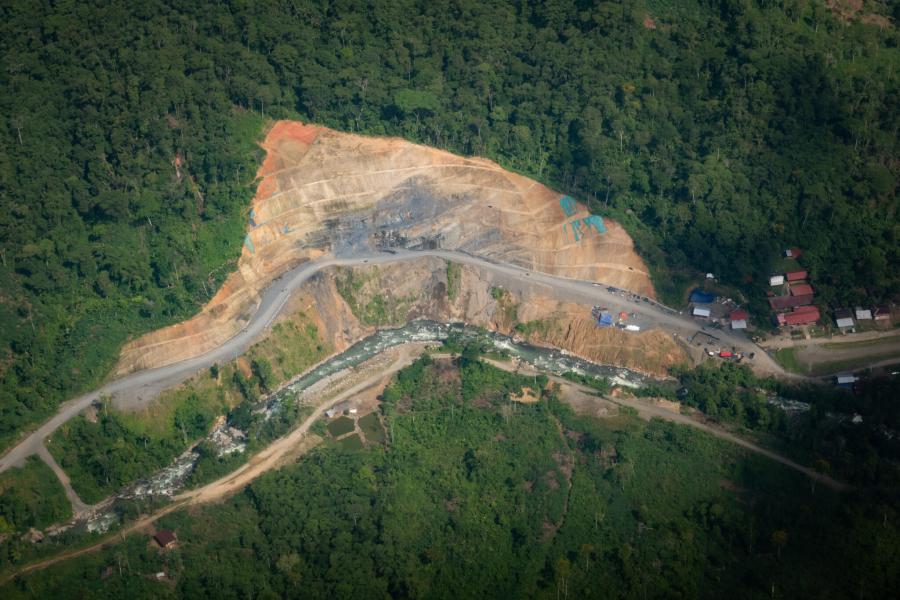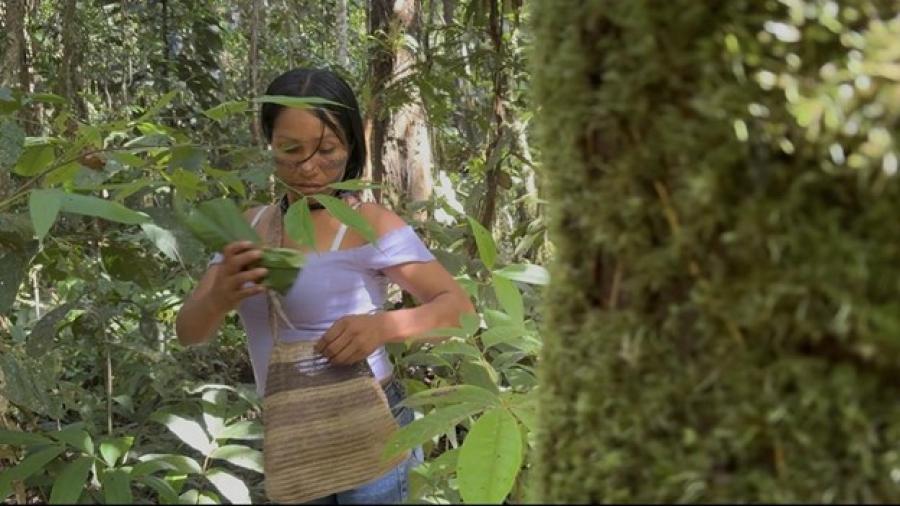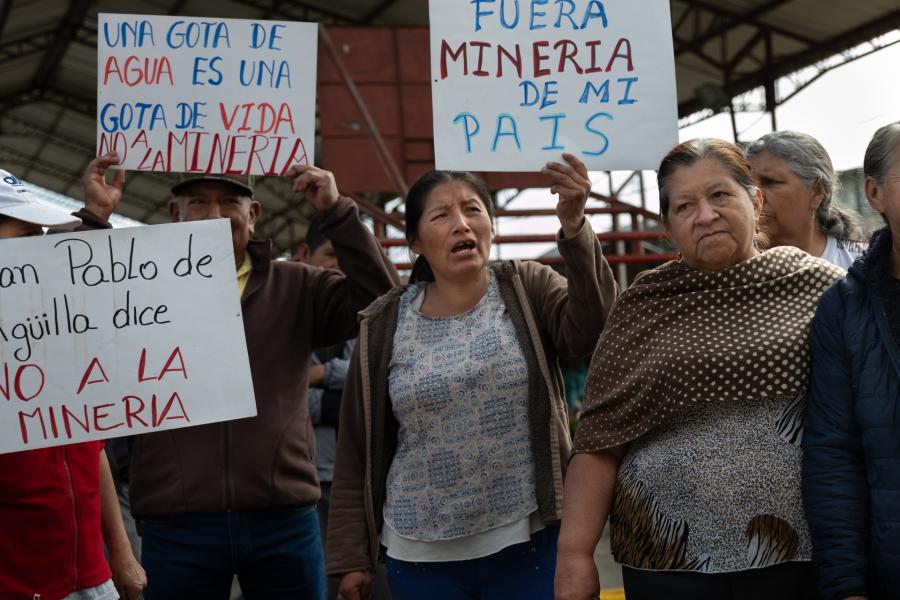A Fractured Fairy Tale
Once upon a time, there was a huge and untouched forest that stretched in its vastness from towering, snow-clad mountains in the west to deep blue ocean waters in the east. It was crossed by giant rivers -- some swirl and turbulent, others deep and placid; but all clean and full of life. The forest, too, was full of life -- ancient and towering trees, myriad vines and air plants, thousands of species of insects, hundreds of varieties of birds, and a bewildering variety of other animals. It was a world of beauty, a place of adventure and never ending experimentation and change.
In this forest, there were many plants and animals, but there were also humans. The humans' responses to the forest were varied: some became navigators of the rivers, others became traders who traveled far into the mountains, while others became farmers or quiet hunters. All lived in the forest, with the forest, and because of the forest, and even when the forest was feared, it always remained at the center of the lives of its humans. But most often, the humans loved it.
But then something new happened. Outsiders came from other lands far away. The forest people loved their forests, but now the outsiders wanted nothing more than to destroy the forest and change it into a very different world. At first, they enslaved some of the people of the forest and killed many others. The people of the forest fled. But eventually, the outsiders reached all comers of the land, and now, instead of killing and enslaving, they taught the remaining forest people to be like them -- to hate the forest and its creatures and to not rest until it should be gone.
Some well-meaning outsiders who came later tried to change all this. They told the remnants of the forest peoples that their ways of life were good, and they tried to help them save the remnants of the forest from destruction. But to the forest people it was all very confusing, because the remnants of forest were too small, the trade routes gone, the rivers no longer clean, and whether they wanted to or not, the forest peoples now needed things the outsiders brought in from the outside in order to survive.
The well-meaning outsiders said not to worry and reminded the forest people that they could keep most of their forest, and destroy only the plants for which outsiders paid money. They counseled the forest people on raising the animals outsiders considered good to eat. But there was never enough plants or animals to sell, and to make the outsiders' plan work meant destroying more forests.
The First-hand Story
To most readers, this introduction is a retelling of a well-worn story -- one that has been presented in many forms in the pages of this journal many times. However, it happens to be a story with a particular impact for me, because I had the fortune to grow up as a forest person, enjoying the clean rivers and unlimited forests, learning the arts and skills of living comfortably in a wonderland of the marvelous, beautiful and deadly. I experienced first hand both the good and the bad of a world, which will never again be possible, at least in the foreseeable future. And I also experienced the crushing physical, psychological, and spiritual impact of the invasion of the outside that erased our world.
In 1955, the Cofan people were the sole inhabitants of more than 1,000,000 hectares of pristine forest in northeastern Ecuador. By 1965, oil exploration and exploitation had begun. And by 1975, the forest was fast disappearing before a massive mestizo colonization, which was brought in by roads created to access vast quantities of oil. The rivers were fouled with chemicals and raw crude; the animals disappeared; boom towns sprung up all over; and the Cofan struggled to survive on less than 15,000 hectares of badly degraded forest. The old life was gone forever, and my companions and I faced the numbing prospect of discarding our culture and way of life, and becoming peasant farmers like so many others, trying to eke out a living from crops and animals which were never meant to grow in this environment. We had been powerless to maintain our forests in the face of outsider pressures to make every given piece of land profitable. If we were to save anything from the wreckage, we needed alternatives, and quickly.
As the only member of my community with an outsider education, I was in a unique position to explore the alternatives available. My first attempts were directed toward modifying the forest to produce more economically valuable products -- a fairly simple concept, but one with many implicit problems. The idea was to selectively remove plants with no economic value and replace them with fruit trees to attract more game; lumber trees for more saleable products, and medicinal plants for potential marketing. But three problems presented themselves immediately. First, the forest's ecosystem is complex for a purpose. The reason there aren't more fruit trees in a given patch of forest is because they are too vulnerable to tropical pests and diseases. Second, although minor modifications and enrichments of a forest are possible, the results per unit of forest compare poorly with the short-term income generated from more destructive forms of agriculture. Third, the turn-around time for a forest-enrichment scheme is measured in decades. We needed an immediate source of income to be able to survive in a world that had changed totally in terms of months and years.
The next obvious option was some sort of controlled lumbering. Selective lumbering offered a solid economic return for a fairly small outlay of time and effort. With a long range plan for enrichment of high demand species, this looked like it might be something that could last for many years. Many of the indigenous peoples in Ecuador were already deeply involved in this. But this was, ultimately, just another way of withdrawing from the bank of centuries for the needs of the moment. And what a tragedy, to take all of our knowledge of the forest and its complexities, and use it merely for finding lumber trees.
As we were wrestling with these possible alternatives, we were also acting as boatmen for the slowly increasing economy on the river. Several of us had managed to buy outboard motors with carefully saved returns from corn fields, animal skins, and short stints as trail makers with the oil companies. We had a long tradition of carving dug-outs, and soon our canoes were traveling up and down the rivers with loads of lumber, corn, and coffee; occasional trips carrying cattle provided excitement and variety. This was not an alternative for the entire community, and it was only viable until roads were built, but it worked as a stop-gap measure for some of us. And unexpectedly, it led us directly into the alternative, which we have adopted as our own in the years since.
Travelers were coming to our region. The roads made it easier than at any previous time, and people from First World countries -- the USA, Canada, England, Germany, Israel, Italy -- began to come, searching for the vanishing rain forest. Most of them were primarily interested in seeing wildlife. This fit with our view of the situation precisely. We had our motorboats. There was still a lot of good forest out there, but it was hard to access with regular paddling and poling expeditions. So when these travelers arrived and wanted to go to "wild jungle," we were delighted to take them. They paid the transportation cost, and we took our shotguns and spears along to go hunting. Our attitude was that if the traveler wanted to go along with us, and didn't mind that we were hunting, why, we were happy to have them along to help carry the game home! From such a pragmatic beginning, we slowly developed our concept of tourism.
There were changes. We soon learned that the traveler had a lot more fun if we modified our normal hunting pattern a bit, and we even got paid extra for it. We found out that the average tourist didn't mind if we shot birds that looked like chickens, even if they were rare. But if we shot a toucan they were outraged, despite the fact that toucans are very common. Tourists preferred a board to a stick as a seat in the canoe, and a pad made them even happier. Tourists' food needed to be somewhat recognizable, such as rice, rather than the lumpy, thick manioc beer we normally eat and drink. But the community as a whole decided early that our role would be that of guides and service providers for tourists interested in the forest. We would not dress up and do dances, or stage fake festivals, or in any way try to sell our traditions and dress. We would not accept becoming the objects of tourism -- rather, we would provide the skills and knowledge for the tourist to understand our environment. We would sell our education, at a price that was in line with its importance to the outsiders who wanted to buy it, such as lawyers, biologists, doctors, teachers, and other professionals the world over do.
Being guides for the tourism experience, not the objects of it, has provided both a very real economic alternative and a very solid incentive for the younger generation to learn the vast body of traditional knowledge, which lies at the heart of our culture. A deep conservation ethic -- the roots of which lie at the hearts of most cultures who maintain a viable relation with their environments -- has helped the Cofan community to create a number of projects which combine outsider science with our traditional knowledge. Interestingly enough, this has also turned out to be an economic success, as many of our projects began to receive funding in recognition of their innovation and replicability in other communities throughout Amazonia.
At present, the Cofan community most involved in both tourism and conservation is my community, Zabalo. Located in what is now part of the Cuyabeno Wildlife Reserve near the northern border of Ecuador with Peru, this community owns and manages over 100,000 hectares of forest in coordination with the Ecuadorean national parks system. With four community-operated cabins, an interpretation center, and a series of trails and camps both in deep forest and on the black water streams of the area, Zabalo plays host in varying scale to over 3000 visitors annually. Most of these visitors come via an Ecuadorean tourism agency, Metropolitan Touring, which operates a floating hotel in the region (appropriately the Flotel), and spend only a few hours at the interpretation center and market. However, perhaps 200 visitors per year spend up to 10 days enjoying the village's programs -- trekking, canoeing, birding, wildlife watching; learning to know the forest intimately in the company of Cofan guides, cooks, and administrators. Both the cabins and the interpretation center generate income for the community. Working as crew and as guides for the groups provides individual income. And the sale of crafts both directly to tourists and to retailers elsewhere in the country is a steady and important source of cash for the families of the community.
In the other Cofan communities, tourism is not as well developed, with a much greater dependence on more acceptable solutions to economic survival. Coffee, corn, and cattle have come to be important, with a resulting loss of forest lands, cultural identity, and standard of living. However, crafts remain important in all but one of the Ecuadorean Cofan communities. Many of these crafts are sold wholesale to Zabalo for resale in the market there, while others are peddled to retailers elsewhere in the country. All of the crafts are developed from natural forest products, and the realization has grown among most of the Cofan that these products provide a better long-term return than crops such as coffee.
Tourism is not for everyone. Some of our experiences have been negative. One of our biggest and most constant headaches is effective commercialization. To operate a community-based tourism business, while maintaining our cultural heritage is not possible using the outsider formula of a tour operator. The implied hierarchy of manager, finance department, buyers, transport specialists, etc., all working eight hours a day, five days a week, with an office and a fax machine is clearly not applicable. Instead, we rely on teams, which rotate in their work, leaving time for farms, family duties, crafts, fishing, hunting and the garden. But the lack of a full-time office makes it difficult to commercialize effectively, and we walk the precarious line between too much tourism (no time left over to live a normal life, and possible loss of our cultural way of life) and too little (not enough jobs, not enough income, lack of attraction for a forest-based life and education for our young people). If we commercialize effectively, we run the risk of the operation snowballing, with more and more tourists arriving, and eventually, we are all wealthy in outsider goods and income but without our culture's wealth of time and interpersonal relationships that we all value so much now. If we don't commercialize effectively, we will wake up tomorrow back at the beginning, with the need to destroy our forest for short-term survival.
But in the overall scheme of things, our experiment with tourism has been overwhelmingly positive. Contact with people who wish to know what we can teach, who value our forests and are willing to pay to help us maintain them has been very important. Our increased awareness of the conservation imperatives facing us has led to many changes in our way of life, all aimed at preserving core values for future generations.
Article copyright Cultural Survival, Inc.



